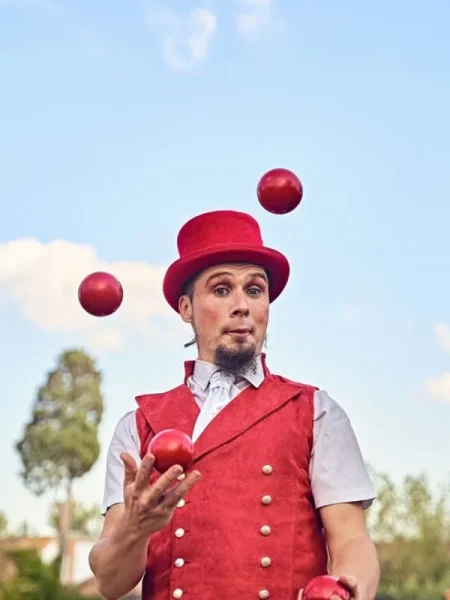Juggling Balls 101
The surprisingly addictive art of toss, catch and repeat
What Is Juggling?
Okay, quick definition first. Juggling (in its most basic form) means throwing and catching objects in a continuous pattern – usually so that at least one is always in the air. The classic version is three-ball cascade juggling. That’s what most people imagine when they think “juggling” – and yes, that’s where we’re starting.
But here’s the thing: juggling isn’t about tricks. It’s about timing, rhythm and control. It’s more like drumming than dancing. More like meditating than performing.
We’ll start with balls, because they’re the most forgiving. Clubs, rings, fire torches? Those can wait.
Let’s be real – juggling sounds simple. Three balls. Two hands. What could go wrong?
It turns out… a lot. Balls go flying. Your hands get confused. Your face might get bonked. But here’s the beautiful part: that chaotic clumsiness? It’s the beginning of something kind of magical.
Juggling is one of those rare skills that looks flashy but builds quietly – through rhythm, patience, and repetition. You don’t need to be an acrobat. You don’t even need good coordination to start. You just need to show up and drop some stuff.
So, let’s get into it. No fluff, no ego – just a clear, honest guide to juggling balls from scratch.
Why Learn to Juggle? (Besides Looking Cool)
Let’s be honest – yes, juggling looks impressive. You toss a few objects in the air and suddenly people assume you’re either a genius or have way too much free time.
But there’s more to it.
Juggling trains your brain and your body – at the same time. You’re sharpening your hand-eye coordination, improving bilateral brain function and calming your nervous system… all while trying not to drop things on your toes.
Some surprising perks:
– Improved focus (seriously – just 10 minutes a day can sharpen concentration)
– Stress relief (you’re too busy tracking the balls to overthink)
– Better reflexes (after a few weeks, you’ll be catching falling objects like a ninja)
– Low-key cardio (especially once you start moving around)
And weirdly? It becomes addictive. There’s something about getting one more clean cycle than yesterday that hits a very specific dopamine button.
First Things First: Choosing the Right Juggling Balls
Not all balls are created equal. And no, tennis balls aren’t ideal. Too bouncy. Too rogue. What you want is something that stays where it lands.
The gold standard for beginners? Beanbags.
Here’s why:
– They’re soft (good for hands and face)
– They don’t roll away when dropped
– They’re easy to grip
– They have just enough weight to stay controlled in the air
You can buy official “juggling beanbags” online (brands like Juggle Dream, Higgins Brothers or Zeekio are solid). Or, if you’re crafty – or just impatient – fill some balloons with rice and double-layer them. Voilà: DIY juggling balls.
Recommended size: about the size of a small orange. Anything too light or too big will mess with your rhythm.
Where Should You Practice?
Short answer? Anywhere with a high ceiling and a soft floor. Long answer? Let me explain.
Ideal spots:
– A quiet room with a bit of open space
– Carpeted floor or a yoga mat (saves your balls – and your back)
– Outside on grass (if it’s not windy)
Avoid juggling near:
– Lamps
– TVs
– Curious pets
– Ceiling fans (trust me)
Also, never try to impress someone on your first day. Juggling is humbling. Give yourself the space to drop balls a hundred times with no judgment.



One Ball, Two Hands – Let’s Start There
You might be tempted to grab all three balls and just go for it.
Resist.
The secret to learning juggling without losing your mind? Start with one ball. Get the rhythm. Get the arc. Let your hands build muscle memory before your brain panics.
Step 1: Stand with your elbows bent, hands about waist-high, palms facing up.
Step 2: Toss the ball from one hand to the other, aiming for a gentle arc that peaks just above eye level.
Step 3: Catch it. Toss it back.
That’s it. No rush.
This teaches your hands where to go. It builds the mental timing loop that juggling runs on. Do this until it’s boring – then add a second ball.
Two Balls, No Panic
Here’s where most people hit the first wall. But we’ll break it down.
Hold one ball in each hand.
Step 1: Toss the first ball (just like before).
Step 2: When it reaches its peak – not before, not after – toss the second ball underneath it to the other hand.
Step 3: Catch both. Breathe.
This is called the two-ball exchange. Your hands are learning to take turns – not to throw at the same time. That staggered rhythm is key. One hand throws a ball, the other one waits.
Do it once. Then do it again. And again. You’ll probably drop one – or both. That’s fine. The goal is smoothness, not speed.
When you can complete 10 clean exchanges in a row? You’re ready for three.
The Big Moment: Three-Ball Cascade
This is it. The classic. The goal most beginners shoot for. The move that makes people go “Oh wow – you can juggle?”
Here’s how to start:
– Put two balls in your dominant hand and one in the other.
– Toss the first ball (from your dominant hand) across your body in that same gentle arc.
– When it peaks, toss the second ball (from your other hand).
– When that ball peaks, toss the third ball (from your dominant hand again).
– Keep going – just one throw at a time.
The pattern? Right, left, right, left. Or left, right, left, right. It’s a cascade—like a slow, steady waterfall.
Don’t try to catch forever. Start by aiming for three throws and three catches. Then four. Then five. Your rhythm will start to settle. Your body will begin to memorize the flow.
And when you finally string together 10 clean throws?
You’ll feel it. That little internal spark. That “I’m really doing this” grin. It’s not a small thing.
Things That Might Go Wrong (And Why That’s Okay)
Let’s normalize the chaos for a second. Juggling involves failure. It’s built into the process.
Here’s what you might run into:
– Balls colliding in midair – That means you’re throwing too early or too high.
– Walking forward unintentionally – You’re leaning. Stay centered.
– Throwing too low – You’re rushing. Slow down the tempo.
– Dropping everything – You’re human. Welcome to the club.
Everyone drops. Professionals drop. People on stage drop. The only difference is, they pick it up with flair and keep going.
Treat dropping as part of the rhythm, not a mistake.
Tricks, Variations, and Showing Off (A Little)
Once the basic cascade becomes second nature, you can branch out.
Here are a few beginner-friendly next steps:
– Reverse cascade: Toss each ball outside the previous arc (a mirror image of the regular cascade).
– Columns: Instead of crossing throws, toss balls straight up in parallel columns.
– One-up two-up: Toss one ball high and the other two low – fun and flashy.
– The tennis ball: Keep one ball going in an arc, while the other two alternate underneath it.
Each trick teaches a new rhythm. You’ll mess up. You’ll laugh. And then it’ll click.
The Mental Shift: It’s Not Just a Skill – It’s a Practice
Here’s where juggling surprises people. After the muscle memory sets in, it becomes… calming.
You stop thinking. Your body takes over. You start noticing your breath, your stance, your focus. It becomes almost meditative.
People say things like:
“I juggle for 10 minutes before work – it clears my head.”
“I use it to reset when I’m stuck creatively.”
“It’s better than scrolling my phone.”
There’s something about that rhythmic movement that pulls you out of the chaos of daily life and into a flow state. And it’s accessible – anytime, anywhere.
How Long Does It Take to Learn?
Short answer: it depends.
Longer answer:
– 5–15 minutes a day can get most people juggling three balls within a week or two
– Total time commitment to basic proficiency? Maybe 3–5 hours
– But to really feel comfortable – fluid, relaxed, confident – it might take a few months of casual practice
The key? Don’t give up after the first frustrating day. The learning curve is steep at first – but short.
And there’s no age limit. People learn to juggle in their 40s, 50s, even 70s. Your hands might be slower, but your patience is stronger.
Final Thoughts: Juggling Is a Skill You Carry for Life
You know what’s wild? Once you learn to juggle… you kind of never forget.
It’s one of those skills like riding a bike or whistling. Your body remembers. Even years later, you’ll pick up three oranges at the grocery store and instinctively toss them into a cascade.
And every time, it’ll feel a little bit like magic.
So, whether you’re doing it to impress a date, to reset your brain or just because your hands need something to do – juggling is worth learning.
One ball. Then two. Then three.
Throw. Catch. Repeat.
And enjoy the drop. It means you’re learning.
